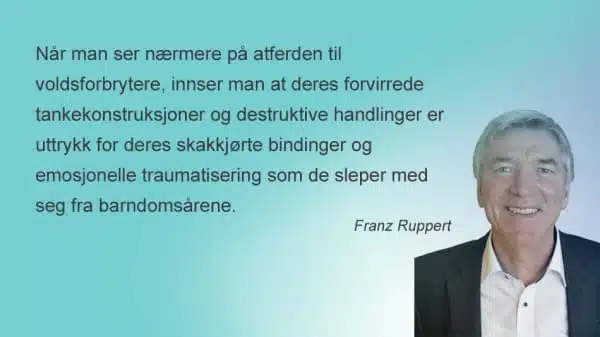Oslo lecture. Podcast Franz Ruppert
Trauma, symptoms and illness
Difficult life experiences leave their mark. Abuse, bullying, incest, sexual assault, insecurity and neglect in early childhood are often behind pain and illness in adulthood. Intergenerational trauma also leaves its mark.
The word trauma is Greek and means to pierce something that is intact. In other words, the body or soul has suffered an injury or wound. Just a few years ago, the word trauma was almost a taboo word. Fortunately, this has changed drastically in recent years. Authors, researchers and journalists have published a large number of books and articles on the subject and the word trauma is now a commonly used word in the Norwegian language. Authors such as Anna Luise Kirkengen, Ane Brandzæg Næss, Kari Killen, Inga Marte Thorkildsen, Franz Ruppert, Marta Thorsheim and others have all published books in 2015 that contribute knowledge about how vulnerable we are as young children, and how violations in our own or our ancestors' childhood leave lasting traces that can be expressed through many different symptoms, even when we become adults. Dr. Gabor Maté's research, published in his book "When the body says no", builds on the work of the authors mentioned above. Knowing about the connection between experiences and emotions can be meaningful, and when something is not meaningless, but understandable, it can be a relief in itself. This may be what it takes to start a process of processing violations and painful experiences. Dr. Siegel's book on neurobiology "Pocket guide to Interpersonal neurobiology" and Joachim Bauer's book "Why I feel what you feel" are important contributions to the understanding of how mirroring through representatives can activate mirror neurons in the brain and make it possible to awaken memories, both explicit and implicit. Trauma leaves traces and can cause symptoms and diseases. They can also be an obstacle to living life the way we want to.
The imprint or early trauma - Gabor Maté and others - excerpt from the film In Utero:
The path from stress to trauma
Traumatic events are not something you just recover from, as is the case with short-term stressful experiences. The same is true of long-term stress. It has the same effect as traumatic events, it causes the same symptoms and can itself lead to traumatization. Traumatic events and long-term stress continue to have an effect on the psyche until they are specifically addressed therapeutically. Any stressful or threatening situation from which we cannot escape by fighting or fleeing (sometimes making the situation worse) is a traumatic experience that can leave lasting wounds. A trauma is therefore an experience where the stress level becomes unmanageable. As a result, we end up in helplessness and intense pain, and the body's normal reaction patterns and defense mechanisms are inadequate. Instead, it resorts to the most drastic survival mechanisms of immobility and freezing. This happens physically in the body (muscularly and chemically), and it happens psychologically by freezing the experience and the memories of it and separating them from the rest of the psyche. In technical terms, this is called dissociation and splitting of the psychological structure.
Thomas R.Verny - the "still face" experiment - excerpt from the movie in Utero
What happens to the psyche when traumatized?
Onno Van der Harth, Ellert R. S. Nijenhuis and Kathy Steel present a two-part model for trauma in their book "Haunted Self": "The emotional personality (EP)" and "The apparently normal personality (ANP)". Through his research and practical work, Prof. Ruppert has described a three-part model where EP = the traumatized part (TD), and where ANP is divided into two meaningful areas: the healthy part (SD) and the survival part (SD). Through this tripartite division, Prof. Ruppert shows in an understandable and recognizable way what happens when we experience more than we can handle and integrate, and body and mind separate (splitting) in order for us to survive. It is only at this stage, when body and mind have to separate in order to survive, that Ruppert describes the event as traumatic. In order for an experience to be traumatizing, we can define these four states:
- Overwhelming. The situation is perceived as totally overwhelming for the person concerned.
- Helplessness. The person involved feels completely helpless.
- Life-threatening. A feeling of not being able to survive, a feeling that existence is threatened.
- Splitting/fragmentation of the psyche into different parts:
- Healthy part: These are healthy structures that have been built up before the difficult thing happened.
- Traumatized part: This is the part of the psyche/soul that contains the overwhelming emotions and memories of the event(s). These are "frozen" in the subconscious, but they lie dormant and can surface at any time, triggered by sounds, smells, events and people.
- Survival part: These are coping strategies that do what they can to prevent the trauma feelings, memories and sensations from the event from surfacing. Also called protection strategies.
Different types of trauma, including love trauma
Trauma can occur as a result of natural disasters, human violence, incest, sexual abuse and lack of love, among other things. They can be further divided into
- Identity trauma
- Love trauma
- Sexual traumatization
- Traumatization of own actions

Prof. Franz Ruppert has researched psychotrauma for 30 years, and the findings support that constellations based on the Intention Method are a good method for all types of traumatization and violations.
Safe and lasting processing of trauma
When processing trauma, it is important that the client is safe and can work at a pace that feels right. The Intention Method, together with our ethical guidelines, facilitates the development and reinforcement of healthy parts, the recognition and identification of good alternatives to survival mechanisms and the processing of trauma within a safe framework. This is how you can take the steps towards greater freedom.
Research and experience also show that trauma is inherited if not dealt with. In other words, your challenges may have their origins in traumatic events your parents, grandparents or great-grandparents were exposed to. Your child's problems may also be rooted in experiences that go further back in the family.
The intention method
The intention method is an effective method for personal development and psychotherapy. The method makes it possible to process, handle and understand what prevents you from living a good life, and to process this. In this way, you will also be able to express your true self. To live as who you really are.
Do you recognize any of these symptoms?
- Difficulties in relationships privately or at work
- Difficulty sleeping
- Unexplained chronic ailments or pain
- Little energy
- Depressed mood
- Concentration difficulties
- Memory loss
- Indecisiveness
- Hyperactivity
- Uro
- Sexual dysfunctions
Then Trauma Therapy with the Intention Method could be for you.
For an introduction, we recommend that you come to our free Information evening .
To gain a deeper understanding, you can look at the offers within self-development or education.








